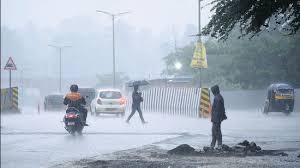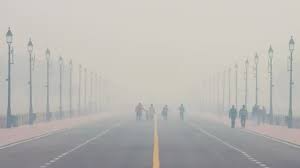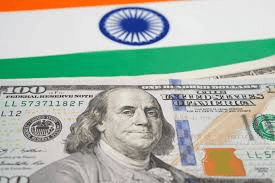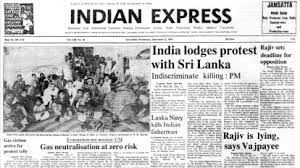
Delhi Today Rain Mayhem
Introduction: Delhi Today
Delhi City is witnessing a turbulent day as heavy monsoon showers batter the capital, stirring traffic snarls, compromising infrastructure, and fueling civic unrest. From protests by lawyers against recent LG-issued court directives to sections of the city streets collapsing once again, Delhi today is an unfolding narrative of resilience amid chaos.
1. Delhi Today : Torrential Monsoon and Traffic Turmoil
The India Meteorological Department (IMD) has issued a yellow alert for Delhi–NCR as moderate to heavy rains disrupt city life across ITO, Connaught Place, Lajpat Nagar, and more. Traffic congestion coupled with reduced visibility has resulted in delays and stress for commuters.

This downpour trend is expected to persist through Monday, further straining already beleaguered roadways and public transport systems.
2. Delhi Today : Law Firms Stage Strike Over LG Court Notification
The legal community erupted in protest after the Lieutenant Governor’s new rule allowing police to submit evidence from stations via video link. The Delhi High Court Bar Association deemed this move a threat to justice and fair trial, launching an indefinite strike in response.
3. Delhi Today : Infrastructure Breakdown Dwarka Road Collapse
Near Delhi’s National Law University, yet another stretch of road collapsed due to waterlogging and poor construction, renewing concerns over urban planning and public safety in capital’s residential zones.
4. Delhi Today : On-Ground Response “Government on Wheels” Initiative
In a rare display of field governance, PWD Minister Parvesh Verma led a “Govt on Wheels” review of Delhi’s Ring and Outer Ring Roads. The inspection targeted open drains, waterlogging, broken pavements, and traffic bottlenecks at hotspots like AIIMS and Kashmere Gate. Immediate remediation deadlines were assigned.
5. Delhi Today : Analysis and Insight Sections
A. Monsoon Impact: A Closer Look
Delhi’s storm response is stressed annually. This year, poor stormwater discharge systems and outdated infrastructure magnified the impact. Cities require urgent investment in drainage upgrades, decentralised water retention systems, and resilient transport networks.
B. Legal System in Flux
The lawyers’ strike highlights growing friction between judiciary autonomy and administrative reforms. Broader implications include delays in hearings, blockages of emergency orders, and decreased access to justice during critical periods.
C. Civil Infrastructure—Failure at the Fault Line
Repeated incidents like the Dwarka road collapse point to systemic laxity in urban infrastructure oversight, especially in colony roads. Water-logged degradation during monsoons exposes building flaws beneath the city’s surface.
D. Real-Time Governance: A Path Forward?
Verma’s “Government on Wheels” initiative presents an effective counter-narrative: local inspections coupled with immediate action. Sustaining this model could help Delhi close the loop between citizen grievances and administrative responses.
6. Delhi Today : Stakeholder Voices
- Commuters lament blocked roads, flooded metro stations, and stranded vehicles.
- Lawyers are mobilizing for legal sanctity, warning of precedent risks.
- Local residents near Dwarka demand accountability—public safety cannot wait for bureaucratic cycles.
7. Delhi Today : Looking Ahead What Needs to Happen
Integrated Stormwater Management – Green infrastructure, permeable roads, decentralized drainage.
Judicial-Civic Coordination – Setting up task forces to fast-track essential hearings during disruptions.
Infrastructure Audits – Rain stress testing of high-risk zones to preempt collapses.
Accessible Governance – Expanding “Govt on Wheels” to all civic departments, ensuring responsiveness during crises.
Conclusion
Delhi, India’s bustling national capital, is experiencing yet another day of turmoil that reveals the city’s ongoing struggle to balance modernization with resilience. From relentless monsoon showers flooding the streets to road collapses exposing weak infrastructure, and from lawyers striking over governance directives to civic inspections on wheels, Delhi today is a living case study of a megacity under stress.
As India’s political, cultural, and economic heart, Delhi faces unique challenges. The city is expanding rapidly, yet every season—and every crisis—reminds its citizens of the fragility of its systems. Today’s events highlight three core themes: environmental strain, civic accountability, and the tension between heritage and modernization.
1. Delhi Today : Monsoon Mayhem Delhi Under Water
Monsoon rains in Delhi are as predictable as they are disruptive. This year, torrential downpours have left major intersections such as ITO, Connaught Place, and Lajpat Nagar submerged. Traffic snarls stretched for kilometers as office-goers found themselves stuck in gridlocks for hours.
Commuter Struggles
The rains have exposed Delhi’s chronic drainage problem. Waterlogging is no longer an isolated issue; it occurs across multiple districts simultaneously. Commuters report stalled buses, stranded metro shuttles, and two-wheelers breaking down in waist-deep water. For daily wage workers, delayed travel translates into lost income, intensifying economic vulnerability.
Urban Drainage Crisis
Experts argue that Delhi’s stormwater systems, many of which date back decades, are woefully inadequate for the city’s current population of over 20 million. Poor planning, clogged drains, and unchecked construction have created a stormwater gridlock. Unless the city invests heavily in modern, sustainable drainage infrastructure, every monsoon will continue to paralyze Delhi.
2. Delhi Today : Civic Infrastructure Collapse Dwarka Road Caves In
The collapse of a road near the National Law University in Dwarka has become symbolic of Delhi’s infrastructure crisis. For residents, this was not an isolated incident but yet another reminder of weak construction standards and poor monitoring.
The Human Impact
For nearby residents, the road collapse disrupted daily commutes and triggered fear about building safety. Parents worried about children walking near weakened streets, while shop owners reported a sharp decline in customers due to accessibility issues.
Accountability Questions
The recurrence of such collapses raises questions about urban planning and oversight. Who ensures that roads are built to withstand seasonal rains? Why are audits not conducted before the monsoon? For Delhiites, the answers remain elusive, while their safety hangs in the balance.
3. Delhi Today : Lawyers’ Strike Legal System in Protest
Adding to the day’s turmoil, Delhi’s legal community staged a protest against a recent notification by the Lieutenant Governor, which allows police stations to submit evidence via video link. Lawyers argue this undermines the fairness of trials and sets a dangerous precedent for administrative overreach.
Justice at Stake
Court hearings across the capital were disrupted as lawyers abstained from work, demanding immediate withdrawal of the notification. Citizens awaiting urgent hearings faced postponements, underscoring how civic disputes ripple into personal lives.
Broader Implications
Legal analysts warn that the standoff could deepen mistrust between the judiciary and administration. At its core, the strike is not only about procedure but also about the integrity of India’s justice system.
4. Delhi Today : Government on Wheels Inspecting Delhi’s Arteries
In response to mounting civic issues, PWD Minister Parvesh Verma launched a “Government on Wheels” initiative, inspecting key corridors like the Ring Road and Outer Ring Road. Officials were tasked with fixing potholes, cleaning drains, and resolving traffic bottlenecks on the spot.
Symbolism of On-Ground Governance
For citizens, the sight of ministers conducting inspections in real time brought hope. It signaled a departure from desk-bound governance toward visible accountability. Yet skepticism remains: will these inspections lead to lasting change or remain token gestures?
5. Delhi Today : Delhi’s Struggle with Identity
Beyond today’s crises lies a bigger story: Delhi’s shifting identity. Once celebrated for its layered heritage—from Mughal architecture to colonial boulevards—Delhi today is seen as a megacity battling environmental strain, civic chaos, and governance challenges.
- Heritage vs. Modernization: Projects like the Central Vista upgrade symbolize progress for some but cultural erasure for others.
- Migration and Social Change: Millions moving to Delhi each decade reshape its cultural fabric, creating both diversity and friction.
- Urban Resilience: Every flood, every road collapse, every strike reminds Delhi of the fragility beneath its glittering façade.
6. Citizens’ Voices
- Commuters: “Every year it’s the same story—floods, traffic jams, and missed deadlines. When will the system learn?”
- Residents in Dwarka: “We don’t just want repairs. We want accountability. Who is responsible for these collapsing roads?”
- Lawyers: “The rule of law is non-negotiable. If procedures are diluted today, justice will collapse tomorrow.”
These voices reflect a city that is engaged, angry, and yearning for genuine solutions.
7. Lessons and the Way Forward
Delhi’s crises today underscore larger truths relevant for all Indian cities:
- Urban Planning Must Be Future-Ready
Drainage, roads, and housing must be built for the city Delhi will be in 2050, not the Delhi of 1980. - Accountability and Transparency
Infrastructure audits should be made public, and contractors held legally liable for failures. - Balancing Heritage and Modernization
Projects must respect Delhi’s identity while creating sustainable spaces for its growing population. - Engaged Governance
Initiatives like “Government on Wheels” must expand into permanent, citizen-driven accountability systems.
Conclusion: Delhi at a Crossroads
Delhi today is not just about clogged roads or collapsed streets. It is about a capital city at a crossroads, struggling to reconcile its heritage with modernization, governance with accountability, and resilience with fragility.
Every flooded street, every road collapse, every strike is more than a headline—it is a reminder that Delhi’s survival depends on planning, accountability, and inclusive governance.
Delhi’s story today may be turbulent, but its future depends on whether its leaders and citizens can transform crisis into opportunity, chaos into reform, and identity shifts into a vision of a city that is both modern and timeless.




